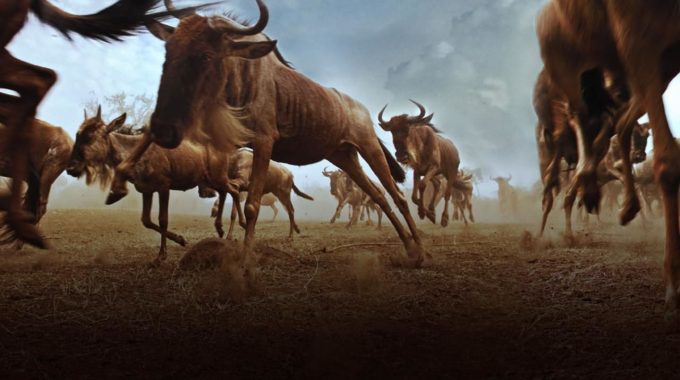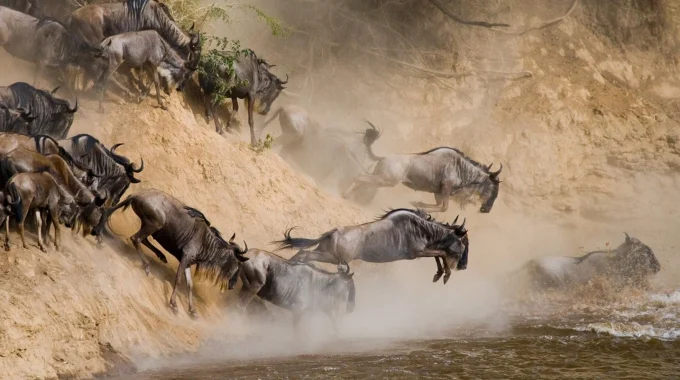A Kenya safari cost can vary significantly based on several factors, such as the season,…
What is the danger of a wildebeest?

What is the danger of a wildebeest? – Wildebeests, specifically the blue wildebeest (Connochaetes taurinus), are a common species in both Kenya and Tanzania, particularly in regions like the Maasai Mara and Serengeti, where they are part of the famous annual Great Migration. Although these herbivores are not typically aggressive by nature, they can still pose certain dangers in specific circumstances. Below are the key factors that contribute to the potential danger of a wildebeest, especially in the context of Kenya and Tanzania:
1. Defensive Behavior
Wildebeests, like many other wild animals, are capable of becoming aggressive when they feel threatened or cornered. If a human or another animal gets too close to a wildebeest, it may charge or show defensive aggression. The dangers of this behavior are most pronounced when they feel their territory or young calves are at risk.
- Charging: Wildebeests can run at speeds up to 50 km/h (31 mph) and can charge if they feel threatened. Their horns, which are sharp and curved, can inflict serious injuries.
- Protecting Calves: Wildebeests are very protective of their young, and a mother may become aggressive if a predator or human comes too close to her calf.
2. Injuries from Their Horns
A wildebeest’s horns are powerful and can be dangerous, especially when used in self-defense. Both male and female wildebeests have well-developed horns that can hurt someone if they charge at them. A direct blow from their horns can lead to serious wounds or even death, particularly if the animal targets the chest or head.
3. Involvement in Accidents
While wildebeests are not usually inclined to attack humans, they do play a role in some road accidents. Wildebeests often migrate across highways in areas such as the Serengeti and Maasai Mara. At night, or during times of low visibility, collisions with vehicles can occur. Adult animals can weigh up to 250 kg (550 lbs), which makes these accidents potentially dangerous for drivers and passengers.
- Migrations and Traffic: During the Great Migration, millions of wildebeests move across vast distances, sometimes crossing roads and highways, leading to vehicle accidents, especially when drivers fail to anticipate their movement patterns.
4. Disease Transmission
Wildebeests can be carriers of various diseases that can be dangerous to humans, livestock, and other wildlife. Some of the diseases they carry include:
- Rinderpest: Though this disease has been largely eradicated in recent years due to vaccination efforts, wildebeests were once major carriers of rinderpest, which could decimate cattle populations.
- Brucellosis: This bacterial infection can be transmitted from wildebeests to domestic livestock, including cattle. It can cause fever, joint swelling, and reproductive issues in livestock.
- Foot and Mouth Disease (FMD): Wildebeests can act as carriers of FMD, which affects livestock populations, including cattle and goats, and is highly contagious.
5. Aggressive Mating Behavior
During the mating season, male wildebeests can become more aggressive as they compete for females. This heightened aggression can lead to territorial disputes, where males may fight each other using their horns in intense battles. While most of the time this behavior is directed at other wildebeests, it can occasionally become more aggressive and injure people who happen to be in the middle of such encounters.
6. Being in the Path of Predators
Wildebeests are prey animals for many large predators, including lions, hyenas, crocodiles, and cheetahs. Although wildebeests can fight off some predators on their own, they are usually attacked in groups during their migration. In such instances, they can be unpredictable and more dangerous due to heightened stress or fear. For example:
- Escaping Predators: If a wildebeest senses that a predator is after it and people are in its way, it may try to run away in a panic, which could cause accidents or injuries.
- Stampedes: During times of high stress or when migrating in large herds, wildebeests can stampede. In a stampede, they might trample over anything in their path, including humans.
7. Vulnerable to PrePredators but Deadly in Defense
While wildebeests are generally herbivorous and non-aggressive, they are still part of a predatory ecosystem, and when cornered or injured, their survival instincts take over. An injured or threatened wildebeest may use its horns or hooves to protect itself.
Context in Kenya and Tanzania
In Kenya and Tanzania, wildebeests play a central role in the ecosystem, particularly within the Maasai Mara and Serengeti National Park, where they are a significant part of the Great Migration. The migration itself presents challenges for both the animals and humans, as thousands of wildebeests cross the rivers and open plains.
- Kenya (Maasai Mara): The Maasai Mara sees large numbers of wildebeests every year as part of the migration from the Serengeti. This area also has a heavy concentration of tourists and wildlife safaris, meaning that human-wildebeest encounters can happen frequently, especially in the form of road accidents and near encounters with aggressive animals during safaris.
- Tanzania (Serengeti): The Serengeti is home to the largest population of wildebeests in Africa. The park experiences the highest concentration of wildebeests during the Great Migration, which stretches from the southern Serengeti to the western and northern parts of the park. This mass movement often puts both humans and animals at risk of accidents, especially with the wildebeests crossing roads or in close proximity to safari vehicles.
Conclusion
So what is the danger of a wildebeest? Most of the time, wildebeests are friendly and will not attack people directly. But when they are angry, stressed, or trying to protect their young, they can be dangerous. Being so defensive could hurt people in car accidents, make them sick, or trap them in a crowd. Wildebeests are an important part of both the natural environment and the tourism industry in Kenya and Tanzania. This means that everyone needs to be careful around them, whether they are from those countries or are just visiting.



